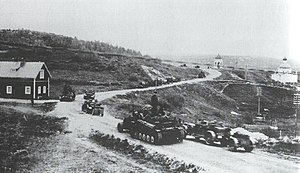
Back عملية الثعلب الفضي Arabic Битка за Мурманск Bulgarian Operation Silberfuchs Danish Unternehmen Silberfuchs German Operación Silberfuchs Spanish عملیات سیلبرفوکس Persian Operaatio Hopeakettu Finnish Opération Silberfuchs French מבצע שועל כסוף HE Silberfuchs hadművelet Hungarian
| Operation Silver Fox | |||||||
|---|---|---|---|---|---|---|---|
| Part of Continuation War of World War II | |||||||
 A German column during the advance on Murmansk, July 1941 | |||||||
| |||||||
| Belligerents | |||||||
|
|
Air & Naval support: | ||||||
| Commanders and leaders | |||||||
|
|
| ||||||
| Units involved | |||||||
| Casualties and losses | |||||||
|
21,501 Germans 5,000 Finns[5] | Unknown | ||||||
Operation Silver Fox (German: Silberfuchs; Finnish: Hopeakettu) from 29 June to 17 November 1941, was a joint German–Finnish military operation during the Continuation War on the Eastern Front of World War II against the Soviet Union. The objective of the offensive was to cut off and capture the key Soviet Port of Murmansk through attacks from Finnish and Norwegian territory.
The operation had three stages. In Operation Reindeer (Rentier) German forces advanced from Norway to secure the area around Petsamo and its nickel mines. Operation Platinum Fox (Platinfuchs; Platinakettu) was an attack from the north by Mountain Corps Norway, as XXXVI Mountain Corps and units from the Finnish III Corps attacked from the south in Operation Arctic Fox (Polarfuchs; Napakettu) to cut off and capture Murmansk by a pincer movement. The German–Finnish forces took some ground but Murmansk was neither cut off nor captured and continued to operate as an important destination for Allied Arctic convoys throughout the war.
- ^ Ziemke (1959), p. 152.
- ^ Mann & Jörgensen (2002), pp. 81–87.
- ^ Ziemke (1959), p. 181.
- ^ Shirokorad (2001), Chapter 3, Part X.
- ^ Ziemke (1959), p. 184.
Cite error: There are <ref group=lower-alpha> tags or {{efn}} templates on this page, but the references will not show without a {{reflist|group=lower-alpha}} template or {{notelist}} template (see the help page).
